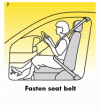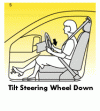- What is the safest way to ride in front of an air bag?
- How do I best protect children?
- What should teenagers and adults do to be safest on the passenger side?
- How do I stay safe when I am driving?
- Will following these safety tips guarantee that I will be safe in a crash?
- Are air bags the reason back seats are safer for children?
What is the safest way to ride in front of an air bag?
First, move the seat rearward and buckle up -- every time, every trip. The lap belt needs to fit over your hips, not your abdomen, and the shoulder belt should lie on your chest and over your shoulder. Remove any slack from the belt. In a crash, seat belts stretch and slow down your movement toward the steering wheel or dashboard. These precautions will give the air bag a chance to inflate before you move forward.
How do I best protect children?
If the vehicle has air bags, never place a rear-facing infant seat in the front passenger seat if the air bag is active. Always secure a rear-facing infant seat in the back seat. In fact, all children age 12 and under should ride in the back seat.
There are instances when children must sit in front because:
- the vehicle has no rear seat,
- there are too many children for all to ride in back, or
- a child has a medical condition that requires monitoring.
When transporting groups of children, instead of placing some of them in the front seat, the use of a second vehicle should be considered as an alternative.
If children must sit in the front seat, they should use the seat belts and/or child restraint appropriate for their weight or size (see What restraint is right for your child?) and sit against the back of the vehicle seat. The vehicle seat should be moved as far back from the air bag as possible. Make sure the child's shoulder belt stays on. If adult seat belts do not fit properly, use a booster seat. Also, children must never ride on the laps of others.
The brochure "Keep Kids Safe: Car Time 1-2-3-4" ( TP 13511 E ) from Transport Canada contains more detailed information on the subject. To obtain a printed copy of the brochure, please refer to the information on the contact page of this site.
What should teenagers and adults do to be safest on the passenger side?
Passengers must always wear seat belts. Seat belts reduce the distance that they can move forward during a crash. Move the seat toward the rear. Even with the passenger seat all the way forward, the distance between a passenger's chest and the dashboard, where the air bag is stored, is usually more than 25 cm. But more distance is safer.
How do I stay safe when I am driving?
Since the risk zone for air bags is the first 8 cm of inflation, placing yourself 25 cm from your driver air bag provides you with a clear margin of safety. This distance is measured from the center of the steering wheel to the center of your sternum. If you sit less than 25 cm away, you can change your driving position in several ways:
- Move your seat to the rear as far as you can while still reaching the pedals comfortably.
- Slightly recline the seat back. Although vehicle designs vary, many drivers can achieve the 25-cm distance, even with the driver seat all the way forward, simply by reclining the seat back somewhat. If reclining the seat back makes it hard to see the road, raise yourself by using a firm, non-slippery cushion, or raise the seat if your vehicle has that feature.
- If your steering wheel is adjustable, tilt it downward. This points the air bag toward your chest instead of your head and neck.
Will following these safety tips guarantee that I will be safe in a crash?
There is no guarantee of safety in a crash, with or without an air bag. However, most of the people killed by air bags would not even have been seriously injured if they had followed the safety tips above.
Are air bags the reason back seats are safer for children?





